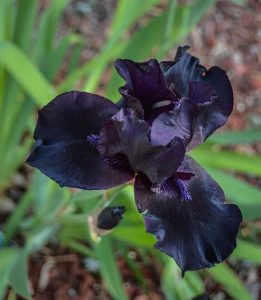Irises: A History In Color
As you gaze at a field of weeds and grasses, a patch of color grabs you. Many plants that were planted next to a back door have outlived the building and the people that resided there. A very tough plant that did just that: survived for a hundred years.
It has been said that when the gods in Greek mythology wanted to talk to the people of earth they sent a messenger. The messenger arrived on a rainbow and everywhere she stepped she left beautiful blooming flowers. The goddess Iris gave her name to the colorful plant we still appreciate today.
Why would this plant of old be of any interest to the present-day gardener? First and foremost, they are tough and easy to grow. There have been 27,000 bearded iris varieties registered by name, with half of that number still in production. Imagine all the colors! With the different varieties it is possible to plant strategically, timing flowering to last several months. Even when the flowers are spent, the blades of the leaves have a unique and special texture, unlike anything else.
Irises are easy to propagate. Planting is relatively simple: 6 to 8 hours of sun, good air circulation, loamy soil, and planted in higher ground so they do not drown. Irises are so profuse that every 3-5 years, depending on how closely they were planted, they must be divided or the blooming will slow down. Easy and beautiful, they make the perfect plant.
Irises are an easy “hand me down” plant. You may shop from a catalog with rhizomes (like an underground stem) being shipped in early summer. Or you may ask a gardener with irises for a small rhizome with a fan of leaves. Start your bed a month before planting by adding soil amendments. Loosen the soil down about a foot; irises have deep roots under the rhizomes. Irises like a soil pH at neutral or slightly alkaline. Check your pH balance to confirm your soil make up.
Iris will use the phosphate nutrient quickly due to their rapid growth rate. If planted in an area that was fallow or with no previous heavy phosphate user, iris often will grow spectacularly. Another nutrient that will create issues for irises is nitrogen. Too much nitrogen pushes too much green growth and may lead to disease. A good soil with organic compost and plenty of micro-organisms will keep your irises happy and healthy.
Iris rhizomes should be planted at the depth to allow the top of the rhizome to be exposed to the sun. The fan of leaves attached to the rhizome will determine the direction of rhizome growth. Wherever the fan is, the rhizome will grow forward. If you plant two fans closely they will fill in quickly and have to be divided sooner. Remember the rhizome is a stem, not a root. Rhizomes need to breathe.
Irises are affected by common diseases such as fungal leaf spot, bacterial leaf blight, soft rot and fungal crown rot. Keeping your yard clean, having good air circulation and proper watering will help.
There are several other irises to enjoy. Siberian irises have smaller blooms and thinner foliage. Japanese irises, or butterfly irises, have flatter blooms and smaller blades of foliage. Both of these irises enjoy slightly acidic soil and increased moisture.
The iris was a favorite flower of many artists, including Leonardo, Renoir, Cezanne, and Claude Monet. Even the historical graphic Fleur de Lys is a representation of an iris pseudacorus. The iris is a beautiful survivor that should be handed down to the next generation.
Julie Silva is a University of California Cooperative Extension Master Gardener of Tuolumne County.
UCCE Master Gardeners of Tuolumne County can answer home gardening questions. Call 209-533-5912 or go to: http://ucanr.edu/survey/survey.cfm?surveynumber=7269 to fill out our easy-to-use problem questionnaire. Check out our website at: http://cecentralsierra.ucanr.edu/Master_Gardeners/ You can also find us on Facebook.

